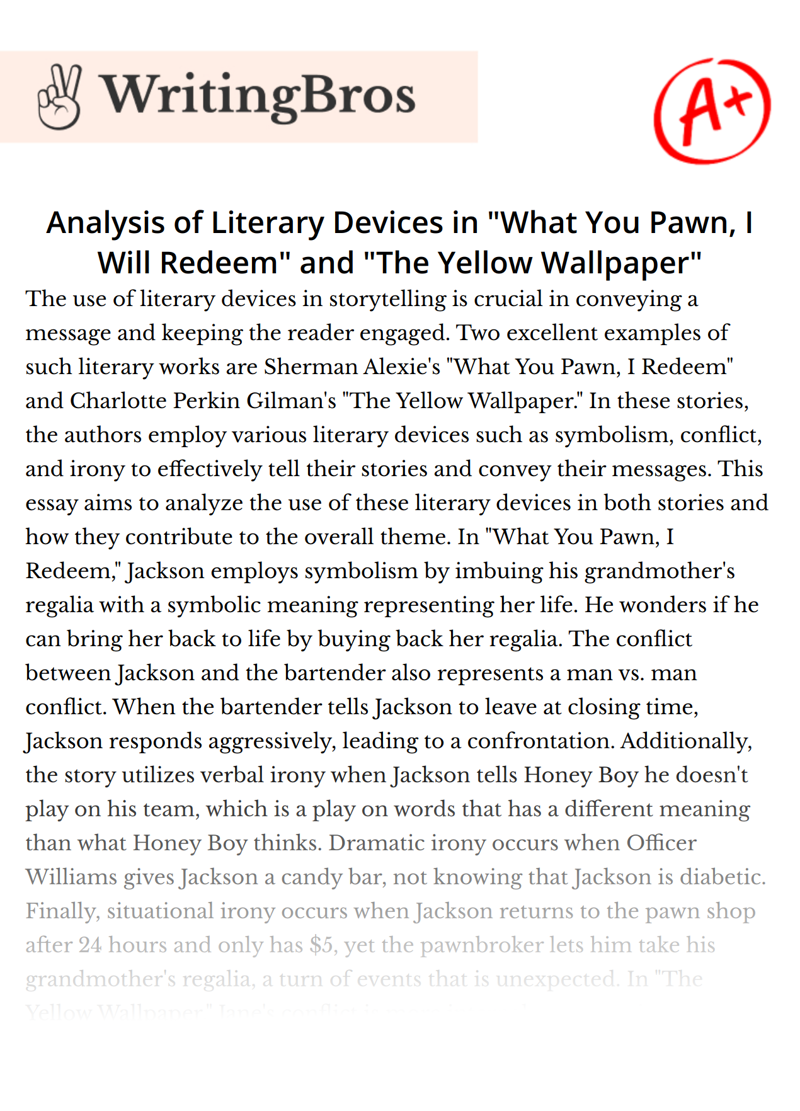Analysis of Literary Devices in "What You Pawn, I Will Redeem" and "The Yellow Wallpaper"

The use of literary devices in storytelling is crucial in conveying a message and keeping the reader engaged. Two excellent examples of such literary works are Sherman Alexie's "What You Pawn, I Redeem" and Charlotte Perkin Gilman's "The Yellow Wallpaper." In these stories, the authors employ various literary devices such as symbolism, conflict, and irony to effectively tell their stories and convey their messages. This essay aims to analyze the use of these literary devices in both stories and how they contribute to the overall theme.
In "What You Pawn, I Redeem," Jackson employs symbolism by imbuing his grandmother's regalia with a symbolic meaning representing her life. He wonders if he can bring her back to life by buying back her regalia. The conflict between Jackson and the bartender also represents a man vs. man conflict. When the bartender tells Jackson to leave at closing time, Jackson responds aggressively, leading to a confrontation. Additionally, the story utilizes verbal irony when Jackson tells Honey Boy he doesn't play on his team, which is a play on words that has a different meaning than what Honey Boy thinks. Dramatic irony occurs when Officer Williams gives Jackson a candy bar, not knowing that Jackson is diabetic. Finally, situational irony occurs when Jackson returns to the pawn shop after 24 hours and only has $5, yet the pawnbroker lets him take his grandmother's regalia, a turn of events that is unexpected.
In "The Yellow Wallpaper," Jane's conflict is more internal, representing man vs. self. She is struggling to accept her condition as a patient with nervous depression while her husband and friends insist that nothing is wrong. She also fights against her own desires to indulge in her fantasies. Symbolism is used to represent her illness in the form of the yellow wallpaper in the house where she stays. The wallpaper's color and pattern represent her own sickly state of mind. Dramatic irony occurs when Jane says her case is not serious, and the reader knows it is worse than she believes. Finally, situational irony occurs when Jane's husband thinks the house is helping her when, in reality, she loses her sanity.
In conclusion, the use of literary devices in "What You Pawn, I Redeem" and "The Yellow Wallpaper" is masterful, providing a depth and richness to the stories that keep the reader engaged and invested. The symbolism, conflict, and irony employed by the authors are integral to conveying the themes of identity, heritage, and mental illness, respectively. Both stories offer a unique and compelling insight into the human experience, and the effectiveness of the literary devices used is a testament to the skill and creativity of the authors.
References
- Alexie, S. (2003). What You Pawn I Will Redeem. The New Yorker.
- Brontë, C. (1892). The Yellow Wallpaper. The New England Magazine.
- Berman, J. (2014). Yellow Wallpaper: Symbolism and Irony. In Bloom's Literature.
- Cornell, S. (1998). The Many Silences of Bartleby. ELH, 65(2), 505-526.
- Doane, J. (1998). The Politics of Exile in Indian Country: Sherman Alexie's "What You Pawn I Will Redeem". MELUS, 23(3), 3-16.
- Gilman, C. P. (2016). The Yellow Wallpaper. Penguin UK.
- Hume, B. (1983). The Yellow Wallpaper: Solving the Puzzle of Charlotte Perkins Gilman's Story. The New England Quarterly, 56(1), 138-155.
- Karpinski, J. (2008). Short Story Criticism: Volume 105. Gale, Cengage Learning.
- Mohanty, N. (2015). Symbolism in Charlotte Perkins Gilman's "The Yellow Wallpaper". Language in India, 15(5), 152-156.
Cite this Essay
To export a reference to this article please select a referencing style below

